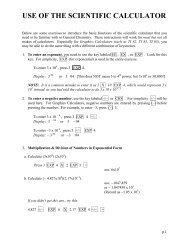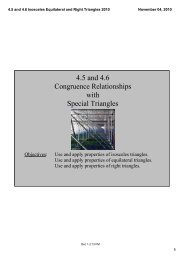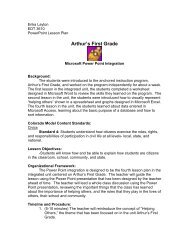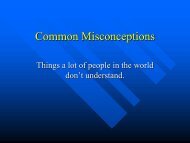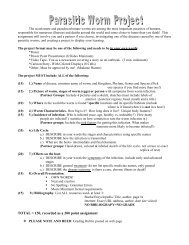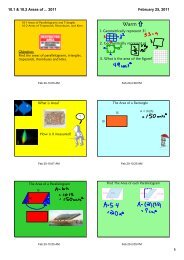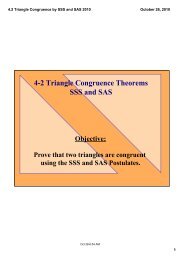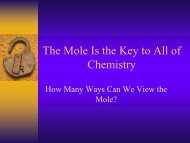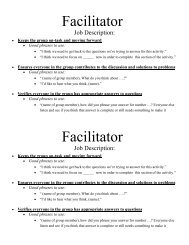Create successful ePaper yourself
Turn your PDF publications into a flip-book with our unique Google optimized e-Paper software.
<strong>Bacteria</strong>
Origins - Three Domain Classification<br />
EU<br />
PROKARYOTES
I. Origins of <strong>Bacteria</strong><br />
Eubacteria<br />
Prokaryotes<br />
Archaebacteria<br />
A. Prokaryotes = 1. Kingdom Eubacteria<br />
3. Prokaryote =<br />
does not have a nucleus<br />
2. Kingdom Archaebacteria
I. Origins<br />
B. 3.5 billion years ago<br />
C. FIRST LIFE FORMS were:<br />
Archaebacteria, or ancient bacteria<br />
(how do we know this?)<br />
early Earth atmosphere had almost no O2 O<br />
D. Eubacteria is true bacteria<br />
(Eu Eu = true) true<br />
�� Eukaryote Eukaryote<br />
= true nucleus
II. Archaebacteria<br />
A. General Info.<br />
1. EXTREME ! Primitive bacteria<br />
2. Live in extreme or harsh environments<br />
B. Three kinds of Archaebacteria:
1. Halophiles<br />
= live in very basic or salty environments<br />
E.g. Great Salt lake, Dead Sea
2. Methanogens<br />
–Anaerobic<br />
(don’t<br />
need O 2 )<br />
–Make<br />
methane<br />
gas (CH 4 ) Swamp
3. Thermophiles<br />
– live in hot or acidic environments (~pH 1-4)<br />
• Near undersea volcanic vents<br />
• Sulphur Springs<br />
• Hot springs in Yellowstone National Park
A. General<br />
III. Eubacteria<br />
1. Ubiquitous = they exist everywhere,<br />
most of the bacti. bacti.<br />
we know<br />
2. Harmful – pathogenic (they cause<br />
disease)<br />
3. Helpful – they have a variety of uses
4. Odd means of getting nutrients<br />
• Chemo – autotrophic (“eat”<br />
• Some “eat” NH3 (ammonia)<br />
chemicals)<br />
• Some “eat” H2S (hydrogen sulfide)<br />
» Sulfide-eating bacteria
Helpful <strong>Bacteria</strong><br />
1. Food & Drink Production<br />
Fermentation (drinks)<br />
– Wine, beer<br />
Dairy products<br />
– Cheese, sour cream,<br />
yogurt, sourdough,<br />
Other<br />
-Pickles, vinegar,<br />
sauerkraut
Helpful <strong>Bacteria</strong><br />
2. Sewage Decomposition<br />
<strong>Bacteria</strong> break down the organic matter
3. Water Treatment<br />
Helpful <strong>Bacteria</strong>
¿<br />
¿<br />
Helpful <strong>Bacteria</strong><br />
Where is most of the Nitrogen<br />
found on planet Earth?<br />
In the atmosphere<br />
Where do plants need it to be?<br />
In the soil<br />
4. Nitrogen Fixation in roots<br />
– Helps plants take up H 2 O and<br />
nutrients from soil
Helpful <strong>Bacteria</strong><br />
5. Bio-mineralization in Mining<br />
– <strong>Bacteria</strong> concentrate desired elements from<br />
ore<br />
– E.g. Au (gold)<br />
Ralstonia metallidurans,<br />
is capable of<br />
precipitating dissolved<br />
gold.<br />
Cu (copper)
6. Bio-<br />
remediation<br />
– Microbes can<br />
help repair<br />
damaged<br />
ecosystems<br />
– Pseudomonas<br />
, a common<br />
type of oil<br />
eating<br />
bacteria, is<br />
used around<br />
the world to<br />
help clean up<br />
oil spills.<br />
Helpful <strong>Bacteria</strong>
7. Human<br />
Recreation<br />
= Artificial Snow-<br />
Making<br />
– <strong>Bacteria</strong> allow<br />
H 2 O to form<br />
ice crystals<br />
Helpful <strong>Bacteria</strong>
<strong>Bacteria</strong>l Classification<br />
1. Shape and Groupings<br />
2. Cell wall composition<br />
3. Environment<br />
4. DNA Sequences
<strong>Bacteria</strong>l Cell
<strong>Bacteria</strong>l Structure<br />
�� Cell Wall<br />
�� Prevents cell from rupturing<br />
�� Composition of cell wall helps to identify<br />
bacteria
<strong>Bacteria</strong>l Structure<br />
�� Cell Membrane<br />
�� F(x) F(x)<br />
= support & protect<br />
�� Differentially permeable<br />
Cytoplasm<br />
�� Cytoplasm<br />
�� Contains organelles (non-membranous)<br />
(non membranous)
<strong>Bacteria</strong>l Structure<br />
�� Genetic Material<br />
�� Single, circular chromosome<br />
�� Plasmid = extra chromosome that can<br />
replicate separately from the main<br />
chromosome<br />
• Use as vector for biological engineering<br />
• Can pass genes for antibiotic resistance to<br />
other bacteria (sometimes resistance to<br />
several antibiotics @ one time)���<br />
time) ���
<strong>Bacteria</strong>l Structure<br />
�� Ribosomes<br />
�� F(x) F(x)<br />
is to synthesize proteins
<strong>Bacteria</strong>l Structure<br />
�� Capsule (Slime Layer)<br />
�� viscous coating outside of bacteria cell wall<br />
�� F(x)s: F(x)s<br />
• Protection<br />
• �� bacteria’s bacteria s pathogenicity (or ability to cause disease)<br />
• Protects bacteria from the Immune System (WBC’s) (WBC s)
<strong>Bacteria</strong>l Structure<br />
�� Other structures (Appendages)<br />
Flagella (protein appendage)<br />
�� Flagella<br />
�� Pili<br />
• F(x) F(x)<br />
= locomotion<br />
• Cell can have one, two, or many<br />
Pili (hair-like (hair like extensions)<br />
F(x)s = attachment to host and transfer of<br />
genetic material<br />
• F(x)s<br />
Fimbriae (shorter than pili) pili<br />
�� Fimbriae<br />
F(x) ) = adhesion to surfaces<br />
• F(x
Flagella
�� A. Typical<br />
1. Coccus/Cocci<br />
<strong>Bacteria</strong>l Shapes<br />
Coccus/Cocci =<br />
spherical or round<br />
Bacillus/Bacilli =<br />
rod-shaped<br />
rod shaped<br />
2. Bacillus/Bacilli<br />
Spirillum/Spirilli<br />
= spiral-shaped<br />
spiral shaped<br />
3. Spirillum/Spirilli
<strong>Bacteria</strong>l Shapes
<strong>Bacteria</strong>l Groupings<br />
�� Groups determined by the plane<br />
in which the cell divides
<strong>Bacteria</strong>l<br />
Groupings<br />
– 1 plane =<br />
• diplo- (pair)<br />
• strepto- (chain)<br />
– 2 planes =<br />
• tetrad (packet of 4)<br />
– Several planes @<br />
random =<br />
• staphylo-<br />
(grape-like clusters)
Identify shapes & groupings
B. Atypical<br />
1. Pleomorphic<br />
<strong>Bacteria</strong>l Shapes<br />
Variable in shape and size<br />
Eg. Stella (stars)<br />
Eg. Arcula (cubes)<br />
2. Mycoplasmas<br />
Lack rigid cell walls<br />
Can change shape
GRAM STAINING<br />
• History & Definitions<br />
– Developed by Hans Christian<br />
Gram in 1884<br />
– Helps to identify different types<br />
of bacteria (a differential stain)<br />
– Stain uses differences in cell wall<br />
composition to differentiate between bacteria<br />
– Can help determine which type of antibiotics<br />
will be most effective against a particular<br />
bacteria
Gram Positive Cells<br />
• Stain purple<br />
– Has thick peptidoglycan layer<br />
• More susceptible to Penicillin
Thick layer of peptidoglycan
Gram Positive<br />
POSITIVELY PURPLE!!!
Gram Negative
Thin layer of peptidoglycan
• Stain pink/light red<br />
Gram Negative<br />
– A thin layer of peptidoglycan<br />
(space)<br />
• Less susceptible to Penicillin than<br />
gram positive
Penicillin (a fungus)<br />
• Antibiotic inhibits synthesis of<br />
peptidoglycan;<br />
peptidoglycan;<br />
used on actively growing<br />
organisms.<br />
–Gram Gram (+) cells �� Penicillin<br />
works<br />
–Gram Gram (-) ( ) cells �� Pencillin<br />
doesn’t doesn t work so well
Overview of Staining<br />
Why do we stain?<br />
•To better view a cell’s structure.
Gram Staining Procedure<br />
Steps (abbreviated):<br />
1) Add primary (1 o ) stain – Crystal Violet<br />
2) Add mordant to cells – Iodine<br />
3) Add decolorizer to cells – Alcohol<br />
4) Add secondary (2 o ) stain - Safranin
Gram Staining Steps
Bibliography<br />
• Thanks to Jordan Sonneberg for the start of this ppt!<br />
• Yellowstone sciences.unlv.edu/.../Pages/episode2.htm Retrieved 11/12/08<br />
• Yellowstone serc.carleton.edu/microbelife/research_methods/ 11/212/08<br />
• Swamp Protegeu http://photos.mongabay.com/pt/Swamp_Shaded.htm Retrieved 11/12/08<br />
• Image of ribosomes sciences.unlv.edu/.../Pages/episode2.htm Retrieved 11/27/07<br />
• Image of <strong>Bacteria</strong>l cell wall pbdb.itan.kyoto-u.ac.jp/saikin-e.html Retrieved 11/27/07<br />
• Map of Great Salt Lake ut.water.usgs.gov/greatsaltlake/index.html Retrieved 11/27/07<br />
• Image of Dead Sea www.pjsoaps.com/1DeadSeaSpa.html Retrieved 11/27/07<br />
• Pickles http://www.getrichslowly.org/images/pickles1.jpg Retrieved 11/12/08<br />
• Yogurt http://wikigreenfrost.pbwiki.com/Helpful+or+Harmful Retrieved 11/12/08<br />
• Sewage treatment plant<br />
http://www.biosolids.com.au/uploads/images/Sewage%20treatment%20process%20v2a.jpg Retrieved 11/12/08<br />
• Water Treatment http://www.saskatoon.ca/org/water_treatment/wastewater_treatment/WWTP1a.jpg Retrieved<br />
11/12/08<br />
• Sauerkraut http://www.recipeathome.info/pictures/1171431564SAUERKRAUT.jpg Retrieved 11/12/08<br />
• Nitrogen-fixing bacteria http://telstar.ote.cmu.edu/environ/m3/s4/graphics/embedded/nitronodules.gif<br />
Retrieved 11/12/08<br />
• Biomineralization of gold http://www.biotech-weblog.com/50226711/biomineralization_of_gold_by_bacteria.php<br />
Retrieved 11/12/08<br />
• Bioremediation http://jackandshaun.pbwiki.com/ Retrieved 11/13/08<br />
• Oil-eating <strong>Bacteria</strong> http://www.jamstec.go.jp/jamstec/bio2.gif Retrieved 11/13/08<br />
• <strong>Bacteria</strong>l shapes http://porpax.bio.miami.edu/~cmallery/150/proceuc/c8.27x3.bact.shapes.jpg retrieved 11/13/08



